

How to Improve Your Compositions in 1,366 Easy Steps. “The drops of rain make a hole in the stone not by violence, but by oft falling” – Lucretius For a long time now, I’ve been publishing the results of my drawing and painting practice here.

People sometimes tell me I’m hard working. They tell me I have a strong work ethic. Sometimes they say I must have a lot of will power. But words like ‘will power’ and ‘work ethic’ suggest that you have to force yourself to do something, to make yourself keep going, and force is a form of violence. In my experience, that’s not the best way to make a hole in the stone. I think a much better way to make progress, the way I try to progress these days, is like raindrops. Each day, one more drop. This approach is not without its frustrations. Just enough to keep you going. Wearing Down The Stone When I first started my composition practice, I didn’t see any real progress for quite some time.
The Delights of Seeing: Pattern, Rhythm and Repetition. Patterns are found everywhere – Nature, Literature, Music and Art.
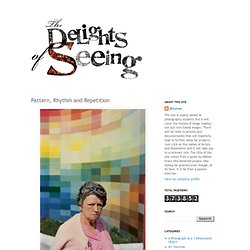
By repeating something again and again it can become something else. In music if you take a sound and repeat it, it not only changes in itself but it can change our mood. Religious chanting is an example of how the sound can change peoples emotions. Even if you are not placed in a trance like state there is a definite change in our mood by hearing repeated sound.Try this yourself - follow this link to use the Tone Matrix. By adding white squares to the grid you can make a pattern that will loop - creating a delicate sound like a music box.
This image is called ‘Ancient Sound’ by the 20th century artist Paul Klee. 'Art does not reproduce the visible but makes visible' - Paul Klee This image reflects Klee’s interest in Colour and Music. The GSW Headquaters in Berlin was designed by Sauerbruch Hutton (1999). El Anatsui creates shimmering large scale artwork made from discarded bottle caps. Design in Art: Repetition, Pattern and Rhythm Tutorial. Repetition is an object, form, or figure that is repeated.

To get an idea of the effect of repetition in an artwork, look at the illustration below. There appears to be two boxes. In the first box, there is one colored circle. The second box is overflowing with multicolored circles, so many that they cannot all be contained within the box. What words do you think of when you look at the two different boxes? Donald Judd: repetition as a minimalist Donald Judd, untitled (1969/1982), anodized aluminum each of 10 boxes 6 x 27 x 24 inches Walker Art Center Gift of Mr. and Mrs.
From the Walker Art Center website: "One of the foremost practitioners of Minimal Art, Donald Judd is best known for his sleek, boxlike constructions made of industrial materials such as aluminum, plywood, sheet metal, and plexiglass. Image from the curriculum guide for the exhibition So, Why Is This Art? Easter Island: Ahu Tongariki, repetition as intimidation. Minimal Art & Minimal Music > Repetition. Repetition is one of the most important techniques of reduction and is applied in art and music likewise.
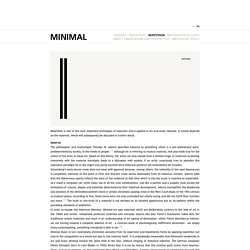
It mainly depends on the material, which will subsequently be discussed in further detail. Material The philosopher and musicologist Theodor W. Adorno describes material as something which is a self-sedimented spirit, predetermined by society, in the minds of people. Although he is referring to musical material, this also holds true for the notion of the term in visual art. Based on this theory, the artist can only choose from a limited range of materials as dealing intensively with the material inevitably leads to a discussion with society.
Repetitive approaches In music there are only few compositions that consist of merely perseverative repetitions. Repetition and chance Repetition creates patterns either according to an exactly defined plan or by chance. Repetition in the Visual Arts. Activity 1.
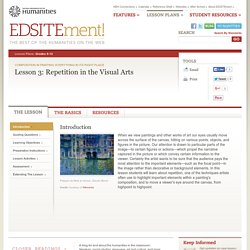
Practice Makes Perfect? Repetition, Rhythm and Pattern. Rhythm & Art: How to Create Effective Visual Rhythm through Marks and Motifs. Whenever movements begin to flow in a repeatable pattern, they become something more—they turn into rhythm.
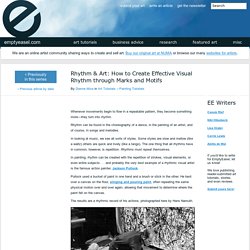
Rhythm can be found in the choreography of a dance, in the painting of an artist, and of course, in songs and melodies. In looking at music, we see all sorts of styles. Some styles are slow and mellow (like a waltz) others are quick and lively (like a tango). Picture Composition Practice with Arthur Wesley Dow. It's 5:45 AM.
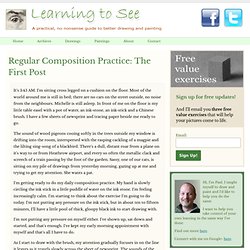
I'm sitting cross legged on a cushion on the floor. Most of the world around me is still in bed; there are no cars on the street outside, no noise from the neighbours. Michelle is still asleep. In front of me on the floor is my little table easel with a pot of water, an ink-stone, an ink-stick and a Chinese brush. I have a few sheets of newsprint and tracing paper beside me ready to go. The sound of wood pigeons cooing softly in the trees outside my window is drifting into the room, interspersed with the rasping cackling of a magpie and the lilting sing-song of a blackbird. I'm getting ready to do my daily composition practice. I'm not putting any pressure on myself either. As I start to draw with the brush, my attention gradually focuses in on the line it leaves as it travels slowly across the sheet of newsprint. My Composition Workstation. Assignment: Composition 1.1 - "Enter the Masters"
START!
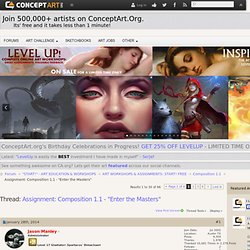
Concept Art Tutorials: Thumbnail-Composition-Basics.